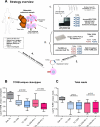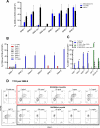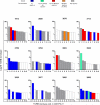Tumor- and Neoantigen-Reactive T-cell Receptors Can Be Identified Based on Their Frequency in Fresh Tumor
- PMID: 27354337
- PMCID: PMC5010958
- DOI: 10.1158/2326-6066.CIR-16-0001
Tumor- and Neoantigen-Reactive T-cell Receptors Can Be Identified Based on Their Frequency in Fresh Tumor
Abstract
Adoptive transfer of T cells with engineered T-cell receptor (TCR) genes that target tumor-specific antigens can mediate cancer regression. Accumulating evidence suggests that the clinical success of many immunotherapies is mediated by T cells targeting mutated neoantigens unique to the patient. We hypothesized that the most frequent TCR clonotypes infiltrating the tumor were reactive against tumor antigens. To test this hypothesis, we developed a multistep strategy that involved TCRB deep sequencing of the CD8(+)PD-1(+) T-cell subset, matching of TCRA-TCRB pairs by pairSEQ and single-cell RT-PCR, followed by testing of the TCRs for tumor-antigen specificity. Analysis of 12 fresh metastatic melanomas revealed that in 11 samples, up to 5 tumor-reactive TCRs were present in the 5 most frequently occurring clonotypes, which included reactivity against neoantigens. These data show the feasibility of developing a rapid, personalized TCR-gene therapy approach that targets the unique set of antigens presented by the autologous tumor without the need to identify their immunologic reactivity. Cancer Immunol Res; 4(9); 734-43. ©2016 AACR.
©2016 American Association for Cancer Research.
Figures



Comment in
-
Zeroing in on Tumor-Reactive TILs.Cancer Immunol Res. 2016 Sep 2;4(9):719. doi: 10.1158/2326-6066.CIR-16-0179. Cancer Immunol Res. 2016. PMID: 27590279
References
-
- Clemente CG, Mihm MC, Jr., Bufalino R, Zurrida S, Collini P, Cascinelli N. Prognostic value of tumor infiltrating lymphocytes in the vertical growth phase of primary cutaneous melanoma. Cancer. 1996;77(7):1303–10. - PubMed
-
- Galon J, Costes A, Sanchez-Cabo F, Kirilovsky A, Mlecnik B, Lagorce-Pages C, et al. Type, density, and location of immune cells within human colorectal tumors predict clinical outcome. Science. 2006;313(5795):1960–4. - PubMed
Publication types
MeSH terms
Substances
Grants and funding
LinkOut - more resources
Full Text Sources
Other Literature Sources
Molecular Biology Databases
Research Materials

